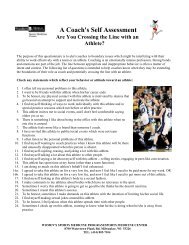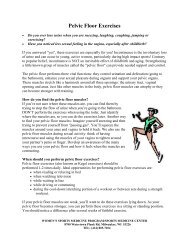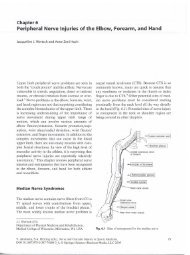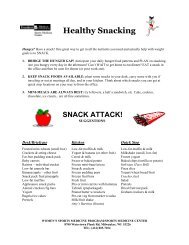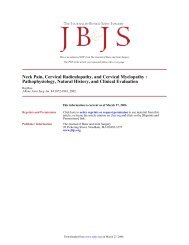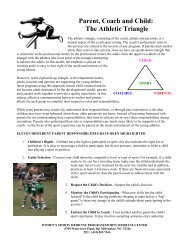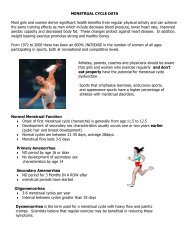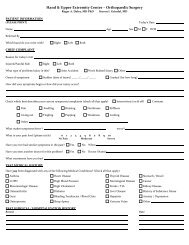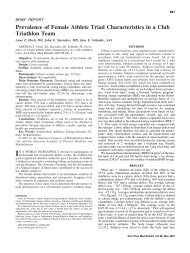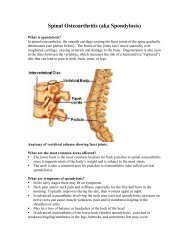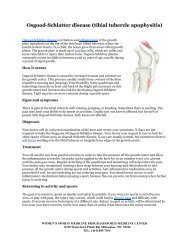Adult Acquired Flat Foot - Medical College of Wisconsin ...
Adult Acquired Flat Foot - Medical College of Wisconsin ...
Adult Acquired Flat Foot - Medical College of Wisconsin ...
You also want an ePaper? Increase the reach of your titles
YUMPU automatically turns print PDFs into web optimized ePapers that Google loves.
Richard M. Marks, MD<br />
Pr<strong>of</strong>essor and Director<br />
Division <strong>of</strong> <strong>Foot</strong> and Ankle<br />
Department <strong>of</strong> Orthopaedic Surgery<br />
<strong>Medical</strong> <strong>College</strong> <strong>of</strong> <strong>Wisconsin</strong><br />
<strong>Adult</strong> <strong>Acquired</strong> <strong>Flat</strong> <strong>Foot</strong><br />
<strong>Adult</strong> <strong>Acquired</strong> <strong>Flat</strong>foot also referred to as Pes Planovalgus is commonly caused by<br />
dysfunction <strong>of</strong> the Posterior Tibial Tendon. This tendon is primarily responsible for<br />
maintaining the arch as well as inverting the foot. The tendon typically loses its function<br />
as a result <strong>of</strong> degenerative changes and less commonly acute rupture. Risk factors for<br />
posterior tibial tendon dysfunction include obesity, age, hypertension, diabetes, female<br />
gender, and systemic inflammatory disorders such as rheumatoid arthritis. When the<br />
tendon is dysfunctional, patients may note collapse <strong>of</strong> their arch or the foot turning<br />
outward (abduction). As the deformity progresses, patients may suffer from lateral<br />
impingement symptoms or hindfoot arthritis.<br />
If the posterior tibial tendon is actively inflammed, a course <strong>of</strong> immobilization with a<br />
boot or cast may be recommended. Other conservative treatment recommendations may<br />
include physical therapy, use <strong>of</strong> an anti-inflammatory agent, and/or orthotics. In advance<br />
cases, bracing may be necessary. When conservative means <strong>of</strong> treatment fail, surgical<br />
treatment may be considered.
Procedure: In patients with a flexible deformity and minimal arthritic changes, surgery<br />
may entail debridement and repair to the dysfunctional tendon. In some cases, a posterior<br />
tibial tendon transfer may be warranted utilizing the flexor digitorum longus (FDL)<br />
tendon. This is usually performed in combination with a corrective cut in the heel bone<br />
called a Medial Displacement Calcaneal Osteotomy to realign the heel. Not<br />
uncommonly, additional bony corrective procedures maybe necessary. These include<br />
placement <strong>of</strong> a wedged bone in the lateral aspect <strong>of</strong> the foot (lateral column lengthening,<br />
Evans osteotomy) or a medial cuneiform opening wedge osteotomy. In some cases, a<br />
subtalar implant (arthroresis) is placed to aid in correction <strong>of</strong> the deformity.<br />
Pre-Operative<br />
Post-Operative<br />
In patients with a fixed deformity or primarily arthritic complaints a Triple Arthrodesis may<br />
be performed. This entails fusing joints <strong>of</strong> the hindfoot including the Subtalar, Calcaneal-<br />
Cubiod, and Talo-Navicular joints. This may be combined with other midfoot fusions to<br />
maintain optimal alignment such as a 1 st metatarsal-cuneiform plantarflexion fusion as shown<br />
here.<br />
Pre-Operative<br />
Post-Operative<br />
Pre-Operative Considerations:<br />
All patients will have a pre-operative medical evaluation arranged either through your<br />
primary care provider or through pre-admission testing at Froedtert. Anti-inflammatory<br />
medications (i.e. ibupr<strong>of</strong>en, aspirin, plavix, or celebrex) need to be stopped seven days<br />
prior to surgery. You will be contacted the day prior to your scheduled procedure<br />
regarding the exact time <strong>of</strong> your procedure and required arrival. Please be punctual. If<br />
you are not contacted by 3:00 PM, please call (414) 805-3285 for procedures being done<br />
at Froedtert’s main OR or (414) 805-9500 for procedures at Sargent Outpatient Surgery<br />
Center.
Following surgery you will be unable to place weight on your surgical extremity thus preoperative<br />
planning is essential. Prior to surgery, an appointment with a physical therapist<br />
will be made for instructional use <strong>of</strong> crutches or a walker as their use will be required<br />
post-operatively. The device will also be fitted to your height during this appointment.<br />
The crutches or walker will be issued at that appointment or arrangements will be made<br />
to obtain the device or arrangements will be through a medical supply company approved<br />
by your insurance. Some patients may opt to use a Roll-a-bout or wheel chair. These<br />
devices can be obtained through your local medical supply store. Please contact the<br />
<strong>of</strong>fice (414-805-7442) with the medical supply store <strong>of</strong> your choice and a prescription<br />
can be faxed in. Regardless <strong>of</strong> the modality used to maintain your non-weight bearing<br />
status, please practice in your home prior to surgery as repetition will reduce the risk <strong>of</strong><br />
falls post-operatively. Removing throw rugs and clearing wider pathways through your<br />
home will also make navigating with crutches or walker easier and diminish the risk <strong>of</strong><br />
falls.<br />
During the period when strict elevation is required (the first ten days) you will need help<br />
with activities <strong>of</strong> daily living such as laundry, cooking, and cleaning. Please plan ahead<br />
and consider having friends or family stay with you. Driving is contraindicated during<br />
the acute post-operative recovery phase and may be prohibited for a longer period <strong>of</strong> time<br />
if your right foot requires immobilization. Showering will also be difficult during the<br />
recovery phase as you are unable to place weight on the surgical leg and cast/dressing<br />
needs to be kept clean and dry. Consider the use <strong>of</strong> a shower chair and/or hand held<br />
shower head. You will need to protect the leg by leaving it outside the shower as well as<br />
using bags or a plastic cast sleeve (brochure available in cast room) to ensure dressings<br />
remain dry.<br />
Postoperative Visits<br />
Day 0-10<br />
• Inpatient procedure: The procedure takes about 2-3 hours. Patients usually<br />
require a 1-2 night stay in the hospital following the procedure.<br />
• Anesthesia: This is done under a general anesthetic. A popliteal block, which<br />
injects local anesthetic behind the knee, may also be administered preoperatively<br />
to enhance post-operative pain control.<br />
• Dressings: Following the procedure, a bi-valved cast or splint will be applied to<br />
the lower leg. This dressing is to be kept clean, dry and left in place until you<br />
return to clinic.<br />
• Non-weightbearing: To ensure optimal surgical results, you will be unable to bear<br />
weight on your operative side. The use <strong>of</strong> crutches or walker is required.<br />
Activities are strictly limited during this time.<br />
• Elevation: Strict elevation above heart level (toes above the nose) for the first ten<br />
days is important to your recovery as it helps to minimize pain and swelling.<br />
Swelling can adversely affect the s<strong>of</strong>t tissue by placing increased tension on<br />
incisions putting them at increased risk for dehiscence.
• Pain Control: Pain medications will be prescribed to be used as needed. Pre-<br />
Operative nerve blocks can last between 8 to 12 hours; however, waiting to take<br />
pain medication until the block has completely worn <strong>of</strong>f can result in increased<br />
breakthrough pain which can be difficult to manage. Please plan accordingly<br />
and take your medication promptly when sensation begins to return to the foot<br />
usually indicated by a tingling sensation in the toes or mild discomfort at the<br />
surgical site. Pain medications may be taken on a scheduled basis in the early<br />
post-operative recovery phase as this is when the pain is most intense.<br />
Day 10 – First Post-Operative Visit<br />
• First postoperative visit with non-weightbearing x-rays, suture removal,<br />
application <strong>of</strong> cast.<br />
• Cast will remain on until week 6. This is necessary to allow for tendon and bony<br />
healing. Until then, cast must be kept clean, dry, and out <strong>of</strong> shower<br />
• Continue with non-weightbearing on operative leg and limited activities<br />
• May elevate extremity as needed<br />
Week 6<br />
Cast removed, weightbearing x-rays obtained, advance weightbearing in a boot from 10-<br />
100% over the next 6-8 weeks with physical therapy with appropriate restrictions.<br />
Advancement <strong>of</strong> activities may be varied based on patients’ past medical history and<br />
radiographic presentation.<br />
Week 12<br />
Weaned from boot at about week 12-14 into regular shoes with orthotics. Increase<br />
activities as tolerated. It may require 10-12 months for complete rehabilitation.<br />
Compliance with home physical therapy protocol following discharge from formal<br />
physical therapy is key to improving strengthening and endurance <strong>of</strong> the foot and ankle.<br />
Swelling can persist up to 6 – 8 months. The use <strong>of</strong> compression stockings can help<br />
diminish post-operative swelling.<br />
Scar Management: Steri-strips, which were placed over the incision following suture<br />
removal, will gradually fall <strong>of</strong>f between week 6-8. Do not pull at these; you may trim the<br />
loose edges. Once the Steri-strips have fallen <strong>of</strong>f, you may massage Vitamin E oil or<br />
Mederma into the incisions twice a day. Silicone gel strips should also be used in<br />
conjunction with the other scar management modalities. These can be obtained from the<br />
cast room.<br />
If any questions arise, please contact the <strong>of</strong>fice at (414) 805-7442 between 8:00 am and<br />
4:30 pm Monday through Friday. Leave your number and message, Dr. Marks, Jamie,<br />
his physician assistant, or Mary S., his nurse, will return your call.



